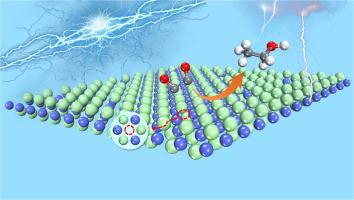Chlorine vacancy−induced activation in two−dimensional transition metal dichlorides nanosheets for efficient CO electroreduction to C2+ products
IF 11.2
1区 材料科学
Q1 MATERIALS SCIENCE, MULTIDISCIPLINARY
引用次数: 0
Abstract
The electrochemical reduction of carbon monoxide (COER) to high−value multicarbon (C2+) products is an emerging strategy for artificial carbon fixation and renewable energy storage. However, the slow kinetics of the C—C coupling reaction remains a significant obstacle in achieving both high activity and selectivity for C2+ production. In this study, we demonstrated the use of defect engineering to promote COER towards C2+ products by introducing single chlorine vacancy (SVCl) into two−dimensional (2D) non−noble transition metal dichlorides (TMCl2). Density functional theory (DFT) calculations revealed that SVCl in TMCl2 exhibits low formation energies and high stability, ensuring its feasibility for synthesis and application in electrocatalysis. The introduction of three−coordinated, unsaturated metal sites substantially enhances the catalytic activity of TMCl2, facilitating effective CO activation. Notably, SVCl−engineered CoCl2 and NiCl2 nanosheets exhibit superior performance in COER, with SVCl@CoCl2 showing catalytic activity for ethanol and propanol production, and SVCl@NiCl2 favoring ethanol production due to a lower limiting potential and smaller kinetic barrier for C—C coupling. Consequently, defective 2D TMCl2 nanosheets represent a highly promising platform for converting CO into value−added C2+ products, warranting further experimental investigation into defect engineering for CO conversion.

二维过渡金属二氯化物纳米片中的氯空位诱导活化,用于将 CO 高效电还原为 C2+ 产物
将一氧化碳(COER)电化学还原为高价值的多碳(C2+)产品是人工碳固定和可再生能源储存的一种新兴策略。然而,C-C 偶联反应的缓慢动力学仍是实现高活性和高选择性 C2+ 生产的一大障碍。在本研究中,我们通过在二维(2D)非贵金属过渡金属二氯化物(TMCl2)中引入单氯空位(SVCl),展示了利用缺陷工程促进 COER 生成 C2+ 产物的方法。密度泛函理论(DFT)计算显示,TMCl2 中的 SVCl 具有低形成能和高稳定性,确保了其在电催化中合成和应用的可行性。三配位不饱和金属位点的引入大大提高了 TMCl2 的催化活性,促进了 CO 的有效活化。值得注意的是,SVCl 工程的 CoCl2 和 NiCl2 纳米片在 COER 中表现出卓越的性能,其中 SVCl@CoCl2 在乙醇和丙醇的生产中表现出催化活性,而 SVCl@NiCl2 由于 C-C 偶联的极限电位较低且动力学障碍较小,更有利于乙醇的生产。因此,有缺陷的二维 TMCl2 纳米片是将 CO 转化为高附加值 C2+ 产品的一个极具前景的平台,值得对用于 CO 转化的缺陷工程进行进一步的实验研究。
本文章由计算机程序翻译,如有差异,请以英文原文为准。
求助全文
约1分钟内获得全文
求助全文
来源期刊

Journal of Materials Science & Technology
工程技术-材料科学:综合
CiteScore
20.00
自引率
11.00%
发文量
995
审稿时长
13 days
期刊介绍:
Journal of Materials Science & Technology strives to promote global collaboration in the field of materials science and technology. It primarily publishes original research papers, invited review articles, letters, research notes, and summaries of scientific achievements. The journal covers a wide range of materials science and technology topics, including metallic materials, inorganic nonmetallic materials, and composite materials.
 求助内容:
求助内容: 应助结果提醒方式:
应助结果提醒方式:


